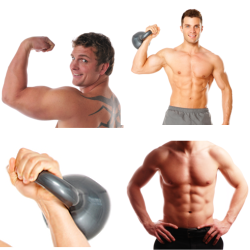The Benefits of Strength Training and Why They Apply to Everyone
Physical fitness is generally divided into two categories. You have cardiovascular training and strength training. Many people falsely believe that you have to pick one or the other – that you either have a strength training personality and strength training goals, or you have to take a cardio approach.
The truth is that the best way to achieve lifelong health and vitality and the best way to lose weight and keep it off is to embrace both. You don’t have to be a lifter or a runner exclusively; you can – and probably should – be both.
There are several reasons why strength training is so beneficial to your health and well-being.
Stronger Bones
Strength training has been proven to help reduce the risk of osteoporosis. It’s important to know that while more women suffer from bone loss than men, men do get osteoporosis as they age. The gradual loss of bone density can cause serious issues, including fractures of the hip and spine. Strength training slows down bone mineral loss.
Strength training also improves your muscle strength and coordination, which in turn results in improved balance and overall coordination. This subsequently reduces the risk of injury and bone damage.
According to a study conducted by the Department of Exercise and Sport Sciences, University of Arizona, Tucson, strength training does have a positive impact on bone density as well as soft tissue lean mass.
The study was designed to evaluate the effects of 18 months of resistance exercise on regional and total bone mineral density and soft tissue lean mass in premenopausal women aged 28-39, who were randomly assigned to an exercise or control group. The results for bone density showed “significant regional increases” for bone density in those women.
Weight Loss and a Kicked Up Metabolism
Obesity in adults is defined as someone who has a BMI of 30 or higher. It’s a weight that is higher than what is considered healthy, and is correlated with many diseases including diabetes, heart disease, and cancer.
Strength training increases lean muscle mass, which burns more calories and has a positive impact on weight loss. To put it simply, muscle burns more calories than fat. Strength training not only burns calories while you exercise, but it also burns calories as your muscles repair themselves.
Strength training accomplishes this by increasing your metabolism to manage the repair process. Additionally, muscles require energy to function – fat doesn’t. By including strength training into your workouts you’re helping burn more calories in the moment, all day, and well into your future. Let’s not forget that obesity is about more than appearances, it’s a health risk.
Obesity is a risk factor for:
- Cancer (including breast cancer)
- Diabetes
- Arthritis and joint pain
- Cardiovascular disease
According to the CDC, Center for Disease Control…
Strength training is crucial to weight control, because individuals who have more muscle mass have a higher metabolic rate. Muscle is active tissue that consumes calories. Stored fat uses very little energy. Strength training can provide up to a 15% increase in metabolic rate, which is enormously helpful for weight loss and long-term weight control.
Muscle burns an estimated three times more calories than a similar amount of fat tissue. Which means if you add a few pounds of muscle you can burn an extra 100 calories daily. That adds up quickly and facilitates weight loss.
A high-intensity strength routine has been shown to bump metabolism by 20 percent for several hours post-workout.
Stop the Middle Age Spread
In their mid-30’s women begin to lose 5 to 10% of muscle strength every ten years. This loss of lean muscle impacts strength, coordination, and mobility. As lean muscle decreases it becomes more difficult to maintain the same level of activity you might have enjoyed ten years ago. Walking, standing, and even rising from a sitting position can become difficult.
Strength training slows down the loss of lean muscle and can build new muscle, depending on your approach. Women don’t need to strive to become world class bodybuilders to benefit from strength training. A simple program can help ensure you’re able to stay active and healthy well into your golden years. No walker required!
Better Mood and Outlook
In a study published in 2005, researchers examined the effect of a three-month exercise program on mild to moderate depression. 80 participants were divided into five groups.
Two groups took on a rigorous program, one of them for three days a week and the other for five days a week. Two groups participated in lighter exercise either three or five days a week. A fifth group, the control group, only stretched.
The results were positive across the board; ratings of depressive symptoms on the standard Hamilton scale fell in all of the groups, including the stretching group. However, those that participated in the rigorous exercise program had the biggest drop – significant enough to equate rigorous exercise to antidepressant medications or cognitive behavior therapy.
Resistance training has shown to reduce anxiety and cause an overall improved sense of well-being. Studies comparing and evaluating resistance training have found that moderate intensity strength training has a stronger impact on anxiety than intense strength training, and this decrease in anxiety can impact sleep and brain function. Still, both intensity levels showed a marked improvement in anxiety levels.
Strength Training Makes You Smarter
Strength training is often used as part of a treatment plan when people suffer from neurological conditions. One of the reasons for this is to help a patient remain as functional as possible. Another reason is that strength training often requires a person to make new mind/body connections.
For example, if you’ve never performed a deadlift or a squat, you have to learn how to safely perform the movement. As you learn the various movements required, your brain begins to tell your body how to move and new connections are created.
As we age, circulation tends to decrease. The results can be uncomfortably cold hands and feet, and a blue tinge is also common in the elderly. Resistance training, which strengthens muscles, requires the heart to pump blood to said muscles and thus also strengthens the heart, improves blood flow to muscles, organs, and to the brain.
This increased blood flow not only helps decrease circulation problems, it also improves cognitive function as the brain receives more blood. Additionally, resistance and strength training require a person to make new connections and perform new movements. You have to think about “proper form” and learn the new exercise techniques.
Joint Pain
Tufts University recently completed a strength-training program with older men and women with moderate to severe knee osteoarthritis. The results of the 16-week program showed that strength training decreased pain by 43%.
The increased muscle strength and general physical performance also improved the side effects of the disease and decreased disability. The study showed that strength training is just as effective, if not more effective, than pain medications and other medications used to treat arthritis. Additionally, similar results have been shown for studies on strength training and rheumatoid arthritis.
Improved Coordination
Increased age often means a loss of balance and flexibility, which in turn results in falls and broken bones. Strength training can improve range of motion and flexibility, and as we discussed above it can improve bone density so any falls that may occur aren’t as damaging.
A New Zealand study looked at women 80 years of age and older, and found a 40% reduction in falls with simple strength and balance training.
A 12-month study conducted on postmenopausal women at Tufts University showed…
1% gains in hip and spine bone density, 75% increases in strength and 13% increases in dynamic balance with just two days per week of progressive strength training.
Sleep Better Too!
People who exercise regularly enjoy better quality sleep. They not only fall asleep more quickly but they wake less often and they sleep longer. This improves disposition and overall health and well-being.
When older adults engage in strength training programs, their self-confidence and self-esteem improve, which has a strong impact on their overall quality of life.
Better Cardiovascular Health
Your risk for heart disease is lower when you have a healthy BMI. Studies have found that cardiac patients gained not only strength and flexibility but also aerobic capacity when they did strength training three times a week as part of their rehabilitation program. The American Heart Association recommends strength training as a way to reduce risk of heart disease and as a therapy for patients in cardiac rehabilitation programs.









